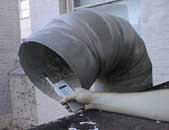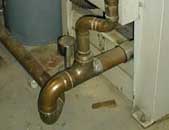|
Overview
We conducted a visit to the YMCA during the weekend of January 14-15, 2001. During that time, we took spot measurements and recorded the physical configuration of the building systems. We recorded time-series data for 5 days during the week following that weekend, January 15-20. Some data was also recorded on a follow-up visit the weekend of February 17-18.
Equipment
- Raytek -- Surface temperature (spot measurement)
- Vaysala -- Ambient temperature and relative humidity (spot measurement)
- HOBO datalogger -- Ambient temperature and relative humidity (time-series)
- Solmate hot wire anemometer -- Air velocity (spot measurement)
Dryer Exhaust Air Methodology
- Spot measurements: Raytek, Vaysala Temperature/Humidity, Solmate hot wire anemometer
- Time-Series Measurements: HOBO Temperature datalogger
- Estimations/Calculations/Research: Talked to dryer manufacturer, Neal Henderson, heat exchanger manufacturers
-
To determine the feasibility of waste heat recovery from the laundry dryers, we:
- Took spot measurements of the exhaust duct wall and the exhaust air to get an idea of the operating temperatures involved
- Took a time-series measurement of the exhaust air to get an idea of sustained operating temperatures and patterns and duration of use
- Estimated the amount of waste heat in the exhaust
- Discussed efficiencies and pitfalls of air-to-air and air-to-water heat recovery systems with industry professionals
Spot Measurements
We took spot measurements of the dryer exhaust duct during our first visit to the YMCA, in order to assess the magnitude of heat energy being exhausted. We were able to gain access to the roof, and measure the temperature, relative humidity, and velocity of the exhaust air at the point of discharge. Because the duct had such a long, uninsulated run outside of the building, we were concerned that our data did not reflect the actual conditions in the duct inside the laundry room. We took surface temperatures of the duct with the Raytek in order to get an approximation of the thermal loss of the air before it exits the duct.
Time-Series Measurements
We were not able to insert a HOBO datalogger into the duct at a point within the building (which would have been optimal), but we did place a HOBO inside the duct on the roof. We recorded the temperature of the exhaust air for a period of 5 days, January 15-20. This gave us an idea of the pattern of dryer operation as well as the range of exhaust temperatures.
Estimations/Calculations/Research
We supplemented the physical data with information from the dryer manufacturer, Cissell Manufacturing (www.cissellmfg.com). We also explored a number of different technologies of heat exchangers, primarily through research on the internet, and email correspondence with company representatives. These dialogs gave us a sense of the operating efficiencies and practical considerations involved with dryer air exhaust.
Greywater Methodology
- Spot Measurements: Raytek
- Time-Series Measurements: HOBO Temperature datalogger
- Estimations, Calculations/Research: Neal Henderson, GFX (Vaughn Corp.), others.
To determine whether greywater heat recovery could be economically feasible at the YMCA, we:
- Took time-series measurements of drain pipe temperatures to understand patterns of usage and operating temperatures
- Estimated the amount and temperature of greywater generated by source (e.g. laundry room, locker room showers)
- Researched greywater heat recovery systems, both user-built and commercial options
- Discussed practicalities of greywater recovery with the YMCA building manager
- Took data measurements to refine estimates, ensure economic benefits of system.
Spot Measurements
We used a Raytek to obtain a preliminary idea of the temperature of the laundry greywater as it passed through the existing copper drain line.
Time-series Measurements
We used HOBO dataloggers to measure the temperature ranges and patterns of operation of the laundry washing machines and the building's sump well. We taped a thermistor to the copper drain line of the washing machines, and recorded temperature data for a two day period, January 14-15. We also collected the temperature of the water in the sump on a subsequent weekend, February 17-18.
Estimations/Calculations/Research
We supplemented these two sets of physical data with a variety of estimated and calculated values related to water consumption and energy use. We generated much of our data on locker room shower usage on conversations with the YMCA building manager, Neal Henderson. For instance, we were able to extrapolate from the number of towels used each day to estimate figures for shower usage. We also based some estimates of shower flow rate and hot water temperature on conversations with Tom Davis, who drew on his experience managing an athletic club in Eugene, OR.
|
|


